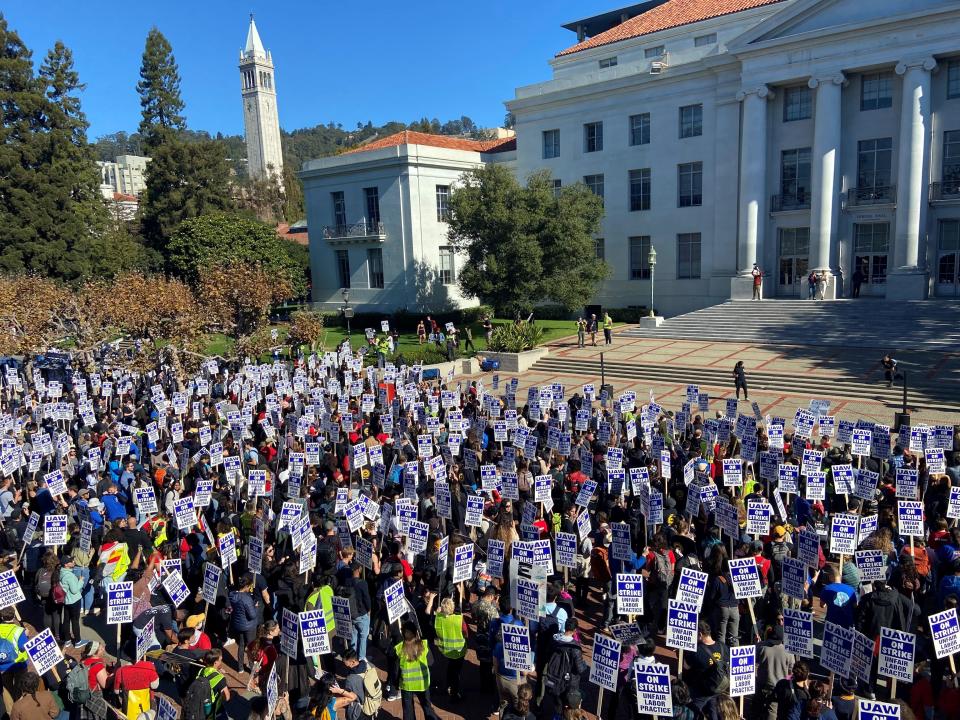Top UAW official gives a glimpse into strategy, what's ahead
Sometimes it's all about connecting the dots, especially when it comes to organized labor.
Most recently, a high-profile strike of some 48,000 academic workers at 10 college campuses in California spotlighted the Detroit-based labor union known for its history of auto industry negotiations. The University of California system issued a statement saying the 40-day walkout had ended. The UAW members, who do much of the research and teaching, had voted to ratify their contracts.
"Under the terms of the new contracts, these workers will be among the best supported in public higher education in the country," said a news release from the University of California.

It is statements like that from employers that help fuel the growth and strength of the UAW on college campuses nationally.
Data from two years ago shows academic workers made up some 80,000 or an estimated 20% of the UAW membership. Harvard University fought the UAW and lost. The union also represents members at Brown University, Boston College, Columbia University, New York University and the University of Connecticut.
This latest victory had a ripple effect and led to significant organizing progress among research scholars at the University of Southern California, a private school in Los Angeles. Organizing higher education has been a major priority in recent years and that is continuing with new activity in Washington State and New York.
Academic workers at The New School in New York went on strike last fall, too, and recently ratified a UAW contract.
UAW President Ray Curry recentlydiscussed the California victory and how it all ties to autoworkers, battery plants and the future of organizing in the South.
The comments below from Curry are direct quotes. The content has been shortened for clarity.
It's electric!: Classic cars get electric makeover by car enthusiasts
Corner office redefined: Why GM's renovated offices include pool table, game areas, treadmills
QUESTION: Why is organizing colleges important to the UAW?
Answer: We see this as a foundational win that just took place. When you look at 48,000 members coming together collectively to be able to be out the weeks that they were out and have demands met. Also, being able to work with the university system and having multiple months of discussion and then weeks of a strike that led to more discussions. And, ultimately, a friendly mediation.
We see this as a long-term growth opportunity that's going to continue to build. It's part of a bigger organizing strategy when we look across different sectors.
Is the UAW ceding the South based on challenges in the past?
We’ve got organizing campaigns on EV startups. We’ve got organizing campaigns on casinos, where we represent table dealers. We’ve got organizing campaigns – most recently the Ultium piece in Lordstown. We’re not going to sit silent. We’re going to reach out to communities across the country where workers want to meet with us, whether they’re in Charleston, South Carolina, they’re in Alaska, they’re in Washington State, or New York. And it just shows the interest that workers still have in joining a historic union that’s been around 87 years.
How do autoworkers feel about academic workers?
Our members are supportive of all members across the country because they know it could be them next.
If you look a year ago at John Deere, John Deere had (national strike) support. That’s an agricultural implement sector union.So our members are willing to take a stand and be supportive wherever that call is. We had people travel across the country to walk those picket lines.
What is the strategy for unionizing battery plants?
We’re in the hunt for the battery work and assembly work. We will be in the hunt for that work with Ford (in Tennessee and Kentucky). Then, also, the work for Stellantis on the location they’re going to have in Kokomo (Indiana). We’re interested in representing all of that work. The one piece we have to remember, and it was stated by the (automakers) from the very beginning, that work at those battery facilities is the powertrain of the future. That will drive electric vehicles and replace the internal combustion engine. We’re looking to represent that type of work as we move forward at every one of those locations.

We just organized Lordstown and Ultium (both in Ohio). Ultium has Spring Hill, Tennessee, and Lansing locations coming on board.
What's different about organizing the South?
I am from the South, born and raised. While I’ve had the opportunity to be able to work globally, my assembly plant was a Daimler Truck assembly plant outside of Charlotte, North Carolina. I was an assembler, grew up through that location and worked the line just like others. That’s a good foundational piece to understand it.

Here’s the challenge: A lot of employers that have come into southern areas, a lot of the transnationals more so than anyone else, they’ve received tax incentives and they have improved current conditions of workers. It doesn’t mean that’s a long-term improvement. That’s the piece that has to be a concern. It’s like a startup. Everything is great, benefits are great. What happens long term? How are workers protected long term? Are workers' voices being heard at the table? We may not get the calls initially on a brand new facility but within a couple years of those facilities starting, we wind up hearing from workers in those locations because they get concerns about safety issues, they have concerns about having a voice at the table.
Most recently, there's the Hyundai situation. We’ve voiced concerns about child labor issues that have taken place there. That was the plant in Montgomery, Alabama. We have those concerns when you’ve got child labor in an assembly plant. They should be in middle school, high school attaining an education and not be part of a manufacturing process.
What does a low voter turnout mean for a UAW election?
Note: Curry, who took the helm after Rory Gamble retired in 2021, is being challenged by Shawn Fain, an electrician who serves as a skilled trades committeeperson and shop chair at the Stellantis Kokomo Casting Plant and also an international representative. The union will mail runoff ballots on Thursday with a Feb. 28 return date. The vote count begins on March 1.
A union election can be no different than general elections or midterm elections across the country. Individuals are either satisfied with where they are or make a decision that they don’t want to participate, or want to be a part of it. There were 1.1 million ballots mailed to the convenience of someone’s home and they got a choice of being able to make a decision on that. Unfortunately, we had right over 10% on this one (in the general election). We’re hopeful numbers will grow on the runoff.
More:UAW election results signal 'discontent' among members as reformers notch big wins
Does the UAW need to be tougher at the bargaining table?
I think tone has to fit, at times, the response or the behavior of the employer. That’s significant about where that relationship is. Sometimes you can set a tone in discussions, set a tone by strategy, set a tone by experience. There’s something to being established and being recognized for bargaining contracts that are successful.
You can’t always be the bully in the room, either. That doesn’t accomplish anything. It doesn’t accomplish anything when that exchange is out there, upfront, as being the bully and you don’t know what the issues are. Or you’ve never been at the table making 9th-hour changes or the 5 a.m. final call, 'Are we going out or not going out (on strike)?' Or the decision to accept an agreement or take it back for membership. Experience will lead you in those situations.
What are upcoming priorities?
As we move into 2023, we'll look at COLA (cost of living adjustment), pensions. There’s not been pension increases since the 2003 agreement in auto. … In our aerospace sectors, every one of our bargaining (contracts) that took place in 2020, 2021, 2022, in every one of those locations, the pensions grew.
Bargaining discussions belong at the table, between members, the employer and elected representatives. Parties have to work together. We’re not going to sit idle, not going to sit on the sidelines.
Contact Phoebe Wall Howard: 313-618-1034 or phoward@freepress.com. Follow her on Twitter @phoebesaid.
This article originally appeared on USA TODAY: UAW President Ray Curry gives a glimpse into strategy, what's ahead

 Yahoo Finance
Yahoo Finance 